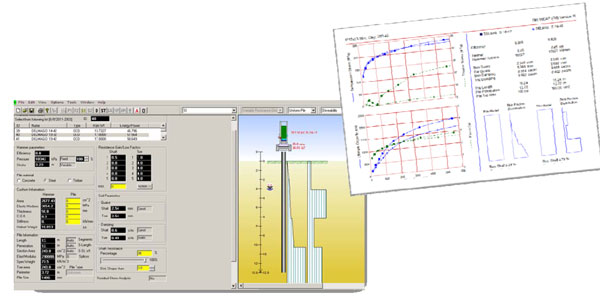 |
Client Login | Join Meeting |
| Home. | About Us | Services | Careers | Satt Associates | Contact Us |

|
Foundation Testing & Evaluation Wave Equation Analysis & Derivability assessment for pile foundation

In a most basic form, dynamic pile testing encompasses visual observations, measurement of the hammer stroke and pile penetration at the time of pile driving. In late 1930’s, engineers analyzed these measurements using energy formulations based on the Newtonion physics of rigid body impaction cushion stiffness, hammer stroke and other driving system parameters that optimize blow counts and pile stresses during pile driving. Wave Equation Analysis of pile driving has eliminated many shortcomings associated with dynamic formulas by realistically simulating the hammer impacts and pile penetration process. It offers a rational means of establishing a relationship among the static capacity, stresses and blow count at the time of pile driving for a particular hammer in a given soil condition. GRLWEAP computer program can be used to perform driveability analysis. A driveability analysis produces a safe prescription for pile installation, including recommendations on cushion stiffness, hammer stroke and other driving system parameters that optimize blow counts and pile stresses during pile driving. Dynamic Testing of Foundation High strain dynamic pile testing using Pile Dynamic Analyzer- PDA® (ASTM D4945) followed by CAse Pile Wave Analysis Program (CAPWAP®)
Dynamic pile testing and analysis are routine procedures in modern deep foundation practices. Dynamic Pile Monitoring is based on the Case Method of pile testing and is known as High Strain Method. It is covered by ASTM D4945 Standard Test Method for High-Strain Dynamic Testing of Piles. Dynamic testing measures strain and acceleration near pile head under a hammer impact provides the basis for a complete analysis of the driving system-pile-soil condition. When the pile driving hammer impacts the pile top, accelerometers and strain transducers attached to it obtain data that is converted to velocity and force readings. Force and acceleration measurements taken near the top of a pile provide necessary information to determine:
During WEAP analysis various assumptions are made regarding hammer performance and soil parameters (available geotechnical information). These assumptions are verified using PDA and CAPWAP results; hence re-calibration of WEAP analysis is performed. "... Before the project started, I was unconvinced that the use of PDA would be a cost-effective benefit to the project. It turned out to be well worth the cost as it frequently provided key evaluations at times when very costly situations required immediate decisions." Walter Grantz Chief Engineer of the Chesapeake Bay Bridge and Tunnel Project. Low strain Pile Integrity Testing OR Pulse Echo Integrity Testing - PIT (ASTM D5882)
The Pulse Echo Test, also known as Pile Integrity Test, Sonic Echo Test and Low Strain Test, is normally performed after pile installation and curing. Pulse Echo Integrity Testing is a non destructive pile testing method that evaluates the integrity of auger cast-in-place (CFA) piles, drilled shafts, driven concrete piles, concrete filled pipes and timber piles. It detects potentially dangerous defects such as major cracks, necking, soil inclusions or voids and, in some situations, can determine unknown lengths of piles that support existing bridges or towers. If major defects exist, the test estimates their magnitude and location; it may also estimate pile length. The impact of the hand held hammer at the pile head generates a compressive stress wave in the pile, and an accelerometer placed on top of the pile monitors the motion associated with this wave. The stress wave propagates down the pile shaft, and is reflected when it encounters either the pile toe or a non-uniformity of the shaft. These reflections cause a change in the acceleration signal measured on the pile top, which is picked up and processed by the Pile Integrity Tester (PIT) equipment and interpreted. It provides following benefits:
|
| Copyright 2012 SATT Engineering Ltd. |
Home About us Services Careers Satt Associates Contact us Client Login | ||||||

